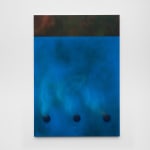-
Natacha Donzé
Mundus subterraneus, 2023Acrylic on canvas170 x 120 cm
66 7/8 x 47 1/4 inCopyright The ArtistPhoto: Marjorie Brunet PlazaWeitere Abbildungen
'Mundus Subterraneus' is a large-sized painting that is precisely divided into two parts, giving the impression that the lower part is overlapping the upper part, the only connection being a..."Mundus Subterraneus" is a large-sized painting that is precisely divided into two parts, giving the impression that the lower part is overlapping the upper part, the only connection being a fine line that snakes its way through both areas. Natacha Donzé douses the larger part in a deep and varying blue, on which fine luminescent lines are arranged like thermal structures. In the lower half she places three dark blue and slightly oval circles that give the impression of an underlying surface. The precise repetition of the shape gives the painting a technical character. Underneath there are tiny luminescent particles that seem to correlate with the holes and are in the process of spreading over the painting. The lines, colors and shapes evoke movement on the whole canvas and a seemingly ever-shifting atmosphere. The title "Mundus Subterraneus" refers to a scientific volume by Athanasius Kircher, that was published in 1665 and that represents the understanding of the earth at that time with written descriptions and illustrations. All of Donzé's works have a temporal level in common that is inscribed in the textures of her paintings, revealing her research into perception mechanisms that are defined by the knowledge and technology of the respective times. These generated images have a great impact on the view humans have of their environment, the world and the universe. They embody the qualities that define the gatekeeper – political, social and cultural structures that virtually or physically control, restrict or facilitate access.
„Mundus Subterraneus“ ist ein hochformatiges Gemälde, das präzise in zwei Bildflächen geteilt ist und somit der Eindruck entsteht, dass der untere Bildraum den Oberen überdeckt, wobei die einzige Verbindung durch eine feine Linie entsteht, die sich durch beide Bereiche schlängelt. Natacha Donzé taucht den Großteil der Fläche in ein sattes, waberndes blau, auf dem sich feine leuchtende Linien zu thermischen Strukturen anordnen. In der unteren Hälfte platziert sie drei dunkelblaue leicht ovale Kreise, die den Eindruck einer dahinterliegenden Fläche vermitteln und dem Gemälde durch die präzise Doppelung der Form eine technische Note verleihen. Darunter befinden sich jeweils kleine lumineszierende Partikel, die mit den Löchern in Korrelation zu stehen scheinen und im Begriff sind sich auf dem Gemälde zu verteilen. Die Linien, Farben und Formen erwecken den Anschein von Bewegung auf der gesamten Bildfläche und einer ständigen Veränderung der abgebildeten Atmosphäre.
Der Titel „Mundus Subterraneus“ verweist auf ein wissenschaftliches Lehrbuch von Athanasius Kircher, das 1665 veröffentlicht wurde und in dem das damalige Verständnis der Erde durch textliche Beschreibungen und Illustrationen dargestellt wird. Donzés Werke vereint eine zeitliche Ebene, die in die Texturen der Gemälde eingeschrieben ist und damit einhergehend Recherchen zu Wahrnehmungsmechanismen, die durch Wissen und Technologien der jeweiligen Zeit definiert sind. Diese generierten Bilder beeinflussen nachhaltig die Sicht, die Menschen auf ihre Umgebung, die Welt oder das All haben und verkörpern dadurch Eigenschaften, die gatekeeper auszeichnet – politische, soziale und kulturelle Strukturen, die virtuell oder physisch Zugänge kontrollieren, einschränken oder ermöglichen.





